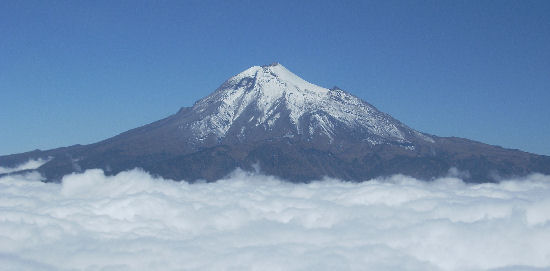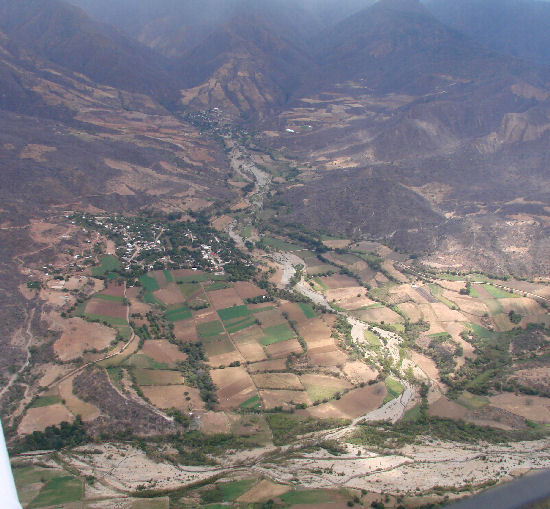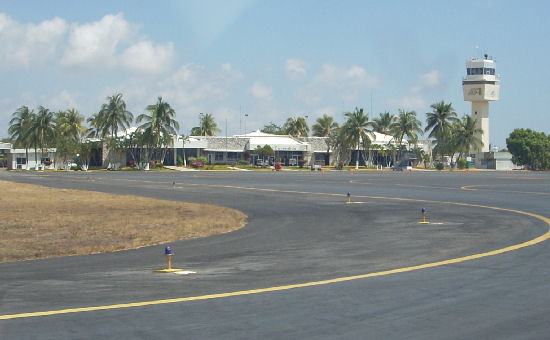
Pico de Orizaba is an unmistakable landmark, dwarfing the other mountains More Photos

San Juan Bautista Jayacatlán (I think) 26 NM north of Oaxaca

Taxiing to the Puerto Escondido ramp
|
 Pico de Orizaba is an unmistakable landmark, dwarfing the other mountains More Photos
|
See .pdf file with maps showing these waypoints.
The MXLEN waypoint is for threading between two rather closely spaced restricted areas, and a third small circular restricted area, MM(R)-1, west of Veracruz. Restricted areas are not shown on the sectional charts so they must be plotted, as well as possible, from the rather low-resolution enroute low altitude charts. The restricted area to the east of the route, MM(R)-115, only extends to 7500' and I plan to be above it. To the right of the route, blocking a direct route to Puerto Escondido, is restricted area MM(R)-102 which extends from the ground to 52,000'. The enroute low altitude chart indicates that it is active by NOTAM (notices to airmen) and I haven't figured out where to get NOTAMs in Mexico. I asked the Comandante in Tampico about it and he said to avoid the area.
The receptionist at the Hotel Bonitto flagged down a taxi for us. It was a chilly morning. The receptionist said she only wore a coat about 3 days per year and this was one of them. Our cab driver, Francisco José Aguirre Fernández, was a "Wingshooting Outfitter" and was eager to take us on any kind of tour outing. We had to pass, but he seemed like a nice fellow and spoke English. He can be reached at ibaraguirre@hotmail.com (833) 211-4787, 044 (833) 293-4089 (cell). He can supply hunting equipment.
We had Francisco drop us off at the General Aviation area at the Tampico Airport. He said he had never been to that area before.
The Flight
See Photos of the Flight.
We went to the Operaciones office and filled out a flight plan, got a weather printout, and paid the airport usage fee, $135 pesos / US$9. We loaded up the plane, did a preflight check, and called the tower on the radio. We taxied to runway 36, departed with a right turnout and headed for Puerto Escondido.
I found an opening in the broken layer of clouds and climbed up above the overcast. We continued a slow climb to our cruising altitude of 11,500', just enough altitude for safe clearance over the mountains. We used GPS navigation and the programmed waypoints to thread our way between the restricted areas. These areas are depicted only on the enroute low altitude charts, not on the sectionals.
We passed Pico de Orizaba, a very prominent half-way marker, and the overcast layer became thicker and higher. I climbed to 12,500'. As we approached the leading edge of the cold front, it became apparent that I probably wouldn't be able to climb above the clouds at that point. As the cloud deck was becoming more solid, I made the decision to circle down through an available opening into a valley that led to Oaxaca City. We cruised along the valley beneath an overcast for about 100 NM and emerged into the sunlight ahead of the cold front just north of Oaxaca City.
I contacted Oaxaca tower and we cruised past our Monte Albán waypoint and continued south in moderately turbulent conditions. With the plane bouncing around and my passengers insisting I "fly the plane!", I was only managed to snap a few photos during this part of the flight. Crossing the Sierra Madres to Puerto Escondido, we looked for signs of the new highway being built between Puerto Escondido and Oaxaca but did not see it. Since there were still low clouds on the south side of the mountains, I elected to remain above them. This wasn't a good idea because we were soon over Puerto Escondido at 10,000' and had to circle for 20 minutes to lose altitude without causing discomfort for my passengers. This is why the flight took 3-1/2 hours instead of the 3 hours 10 minutes I had planned.
At the Puerto Escondido Airport (MMPS)
We taxied to the ramp where a lineman guided us to parking. We were parked in the corner of the ramp next to a palapa shack where the Federale hung out. The Federale came over and took down the usual information. It is easiest if you just ask for his clipboard and fill out the information. There were only 3 other general aviation aircraft on the ramp. One was owned by a frequent visitor, another was an air taxi to Oaxaca, and the third was a Bonanza owned by a local pilot who drinks a bit. We made our way to the terminal. I found out later that they want you to walk on the red line at the edge of the ramp when going to and from your plane. At the terminal, I found the office of the Comandante where I filled out the Close Flight Plan form. I spoke to the Comandante about my intention to make a flight to photograph the playas later in the week. I wanted to fly over the ocean at 500'. He said there might be a problem with that when near Puerto Escondido due to helicopter traffic but that we would see about it when the time came. He did not speak English. Then I went to Operaciones, which is outside, and refueled the plane. Everyone I dealt with at the airport was very friendly.
Now on to Photographing the Playas.